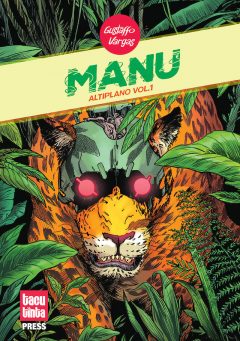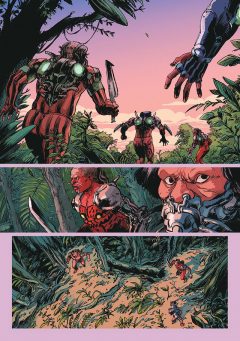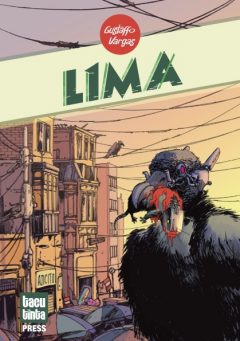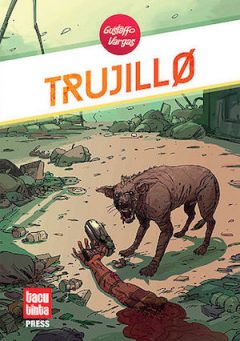“I take ingredients from different places, combine them and see what kind of result I get” Gustaffo Vargas on his recipe for success with MANU, Trujillø and L1MA
Set in a world of cybernetic jaguars, tooled up mercenaries and enigmatic hitwomen – all in the Peruvian jungle – Gustaffo Vargas’ MANU was our favourite book from the recent Thought Bubble Comic Festival. Keen to find out more about the secrets of Gustaffo’s world building and the inspiration behind MANU, and his previous work L1MA and Trujillø we caught up with him to find out more.
 Can you tell us a bit about the inspiration and story behind MANU (and also Trujillø and L1MA)?
Can you tell us a bit about the inspiration and story behind MANU (and also Trujillø and L1MA)?
Gustaffo Vargas: By the beginning of 2014 I wanted to tell a science fiction story based in Peru. Then I realised I wanted to make a cyberpunk story, and as soon as I decided what elements I wanted to use the place where it would happen came to me rapidly (Trujillo). This first part of the process was more thinking and rethinking over and over than writing, when things look more solid and clear in my mind is only that I started writing things on paper.
I didn’t manage to do Trujillø first because of a lack of time, I wanted to publish a fanzine just before leaving Peru by the end of 2014 and I had only a couple of weeks for printing and to bring it to a small Fanzine festival called CARBONCITO. So I came up with the idea of 1Quitos (which takes place in Iquitos city, in the Peruvian rainforest) the first story I actually drew and printed about these world. It follows the story of XOLO, the protagonist of Trujillø, and it was printed in a small black & white fanzine called TACUTINTA, which contained several short comic stories and drawings from my talented good friend Gino Palomino and I.
I was already drawing a couple short stories for Dave West from Accent UK and for Future Quake Press when I decided I wanted to bring Trujillø to life. I just needed to do that book. I took some copies to Thought Bubble 2017 and showed it to some artists and editors, his official release was later in Leicester Comic Con in 2018.
The idea of making books that happen in real places came naturally. So the next story after Trujillø was L1MA, which is the capital city, my city. This was a new story, the only thing I knew in the beginning was, I want to tell a story with street kids (pirañas) and black vultures – that happens in Lima. It is a love letter to my city, in my own way. L1MA was released in Thought Bubble 2018.
All my stories happen in the same world, so little by little, especially with MANU, characters and elements might connect or cross paths more.
I think sometimes of my writing as a Peruvian cooking thing. Peru has 3 very different regions, the Coast, the Andes Mountains and the Jungle, so it has a huge variety of fresh products. We’re very influenced by many different cultures, we used to be a Spanish colony and we also have a lot of Chinese, Italian and Japanese influences. So our food is very varied in fresh products and has all these influences from these many other kitchens, and we mix them all. We have a huge variety of dishes from different regions but we still keep on mixing them all the time, not being afraid of what will come of those combinations and see what new thing might appear. I think my comic ideas work a bit like that, I mix and match and take ingredients from different places, combine them and see what kind of result I get. (I hope all this is making sense!!)
 What inspired you to mix dystopian sci fi and South American jungles together?
What inspired you to mix dystopian sci fi and South American jungles together?
GV: I wanted to explore what I knew and where I came from, go deeper in my own culture, I think it’s a territory that is so rich!
In some moment that idea might have come when I was thinking in Miyasaki’s films and other Japanese animation films and tv series. In Anime you have really varied stories and they use heavily their culture and folklore in very different and creative ways. Ideas and visuals are amazingly rich and that’s when it hit me. In Peru (and all South America) we have such rich and fascinating cultures, maybe I should explore Peru with that kind of vision.
Do you use a lot of reference material to get the look of the Incan style characters right? Or are you just basing them on things you would see growing up in South American?
GV: Yes, before and after I have the plot of a story, I do a lot of research, not only visually, but trying to understand the mood and characteristics of a city, of the ancient culture that flourished hundreds of years before in that same place and all the pieces that connect and influence that very same place.
Are they Incan, or Aztec? We just assume they are Incan, but please tell us if we are wrong here!
GV: The biggest Empire in South America was the Inca Empire, the biggest in North America (Mexico) was Aztec. But before them there were many other Pre Columbian cultures that were annihilated or absorbed by the Incan Empire. I focus and explore those cultures: Chavin, Mochica, Huari, Tiawanaco, Chavin, Paracas, and many others.
MANU is much longer than those first two books, were there any challenges to writing a longer story? Or did you enjoy getting a chance to tell a longer and more ambitious story?
GV: It was quite a different challenge. L1MA and TRUJILLO are fast roller coasters that go from A to B. I wanted to do a bigger and more ambitious story. It was not easy, I had to prepare a Mind Map and small events cards to make all the elements work (and hopefully the will!) but the same it was plenty of fun.
 You mentioned to us at Thought Bubble that this is part of a 3 volume series, how will the story develop?
You mentioned to us at Thought Bubble that this is part of a 3 volume series, how will the story develop?
GV: I wanted to explore a couple of themes that started with L1MA. So I started plotting the whole story, and at the moment I was writing the main bits I realised that this was going to be a bigger creature. I had a 100-110 page story. I wanted to bring a new book for Thought Bubble, and with that many pages it just wouldn’t happen. So I decided to cut the book in 3 parts. So it’s all planned and plotted, all the main events are clear, including the ending.
Can you tell us a bit about what the name MANU actually means? And the names like Altiplano?
GV: MANU is the National Park that is in the Peruvian rainforest, I always take names from actual places, and that’s where the story begins.
ALTIPLANO means Highlands and is also one of the areas in the Peruvian Mountains where many important events of the story will take place.
Little by little I’m using more Spanish and native languages (aymara, quechua, ashaninka, etc) in my books. When it’s necessary I put a caption with the translation, but less often now. It’s like when you visit a foreign place, you won’t get everything and that’s ok, the context will make you understand the whole. Even I don’t understand all the words in some conversations and that’s ok, you know you’re in a different place.
What comics, books and movies inspire you as a writer and artist. And are there any which inspired the world of MANU?
GV: I have influences from many places: Alvar Mayor and Marco Mono by Trillo and Breccia, El codigo Guastavino by Trillo and Lucas Varela, the longest day of the Future by Varela, Paul Popes Batman 100 and 100%, David Rubin’s The Heroe, Grendel, Black Hammer, Hawkeye by Fraction and Aja, Simon Roy, anything that Frederik Peeters does, Gabriel Ba and Fabio Moon, the list might keep going on…
I love science fiction in general, but it’s hard to find good science fiction movies, but again I like different types of movies, so I might watch a Marvel movie and later a 70s French film, a comedy and then a thriller, movies I love that might have influenced my world: Blade Runner, Miyasaki Films: Nausicaa, Spirited Away, Princess Mononoke, Drive, Apocalypse Now, Pulp Fiction, Kill Bill, Y Tu mama tambien, Martin Hache.
I don’t have that much time to read books these days, but books that might have influenced my stories: Jorge Luis Borges Fictions and The Aleph, Johnny Mnemonic and the Neuromancer Trilogy, Dune, Dance Dance Dance by Murakami, Un único desierto by Enrique Prochaska, La Palabra del Mudo by Julio Ramon Ribeyro.
 What is your background in comics? Did you make any books before Trujillo and L1MA? Did you make any before you came to England? How long have you been in the UK for now?
What is your background in comics? Did you make any books before Trujillo and L1MA? Did you make any before you came to England? How long have you been in the UK for now?
GV: I did comics since I was a young kid, He-Man adventures and so on, and I stopped when I was 18-19 years old, I started my career in fine arts at University and comics didn’t fit in (which was silly, and even sillier of me to stop).
There was a very big pause not making any comics. During my first visit to Europe in 2012 I went to The Cartoon Museum in Belgium and huge Bande Desineé shops in Paris, and I ran out of excuses for not having the time to make comics. Two weeks after coming back to Peru from that trip I was already making comics. Giancarlo Roman and I created a science fiction story of a guy that had a black hole in his chest, the story took place in a not so far future dystopian Peru, sadly I don’t find any time to finish that story. I also illustrated a very Mignola-esque influenced story by Giancarlo Roman of a Robot with a carved head.
After a year and a half of being involved in these projects is that I started developing TRUJILLO.
I arrived at Leicester UK in February 2016, so almost 4 years ago. All my published work has happened during this time, I’ve kept myself really busy and putting all the hours I could to improve my skills.
The panels in MANU are quite different and you seem to enjoy trying our new and exciting layout? Is it important for you to try new things like this in each issue to make you a better artist?
GV: That is essential to me. If you don’t make mistakes how are you going to learn? So, yeah, I love trying new ways to play with panels, page composition, displaying and organising the number of pages and sequences and also play with the use of colour.
If you’re afraid of trying something new you won’t challenge yourself so you will not improve your skills, and also it’s more fun!
 Your work has a very 2000 AD feel to it, would you like to end up working for them or for Marvel and DC? Or just keep making your own comics?
Your work has a very 2000 AD feel to it, would you like to end up working for them or for Marvel and DC? Or just keep making your own comics?
GV: I’d love to do both. To be able to work on my own worlds and also to be able to work with writers and publishers where I’d enjoy telling their stories it’s the dream.
Until now, all the independent projects I’ve been involved as an artist have been a lot of fun. If you’re not interested and inspired by the story you’re drawing would make it hard to keep it up and probably you wouldn’t try to come with new and different takes on the pages.
And finally, which of your characters has been your favourite to draw and were there any which were so difficult to draw that you regretted it? Creating a character based on a jaguar must have been a challenge!
GV: I think I have fun with almost all of them, the kids, the dogs, the vultures, the cyborgs, they all serve to tell the story, so, I’m not sure if I might have specially more fun doing one from another. I think I have my fun creating the characters, but they serve a purpose, to tell the story.
The more complex designs can be a pain, but they are worth it. I don’t regret it, but sometimes it might feel a bit like a drag. The Priest with robot arms in L1MA was very complex to do, luckily he didn’t appear in that many panels. But again, he might appear again in another story when he is still alive, so you never know.
The jaguar in MANU and all the monkeys were a bit of a challenge, but they were fun too, Sonia’s design changed as I was pencilling the book. Her tattoos came in the end and it was a bit of a headache to repeat the patterns on so many pages, including the feet!
But those details are what sometimes gives that extra bit to your world building and gives them that extra spicy plausibility you’re trying to achieve.
You can purchase MANU, Trujillo and L1MA from gustaffovargas.bigcartel.com And follow Gustaffo on twitter @gustaffovargas and instagram @gustaffovargastataje



August 22, 2025 @ 2:18 pm
Can you be more specific about the content of your article? After reading it, I still have some doubts. Hope you can help me. https://www.binance.info/it/join?ref=S5H7X3LP
October 8, 2025 @ 10:28 pm
This content stands out from the rest. Watch ary news news — 24/7 Urdu headlines, live bulletins, talk shows, and developing stories with fast, reliable streaming and crisp HD playback across devices.
October 23, 2025 @ 7:48 am
I don’t think the title of your article matches the content lol. Just kidding, mainly because I had some doubts after reading the article.